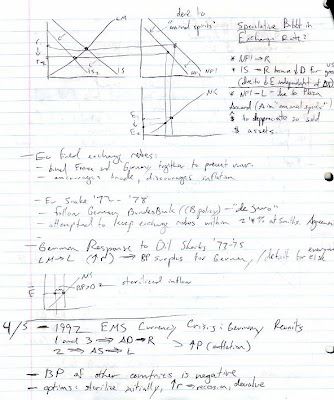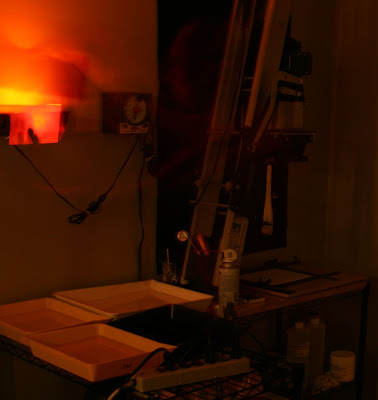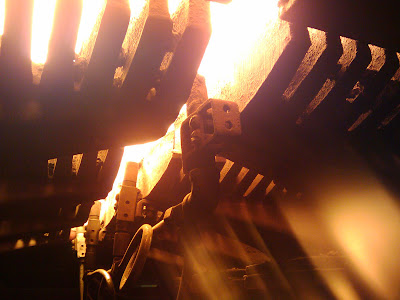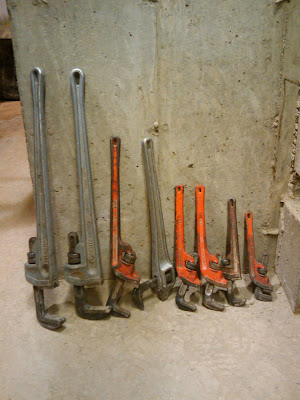This is the
article that brought this up
again. I think about sustainable asset value often (I just made that term up)... hm, it's almost like green spending. The article talks about where the money goes when the stock market goes down 50%; it literally disappears. This is because the current value of a stock reflects the companies expectations for future earnings... earnings forecasts are, in short, shit right now. Hence, stock prices fell and tend to reflect the explicit value of the company as opposed to its explicit (concrete) plus implicit (earnings potential) values. This is true of goods you purchase too. A good has its use (implicit) value and its scrap (explicit) value.
EDIT: I've been told this is concept is confusing so here's an example. When you first buy a couch it it has the potential to be sat on maybe a grand total of say 10,000 hours which is the implicit or potential value of the couch. The longer you own it the less potential it has to be sat on, it just wears out. Its implicit value thus decreases with use. Potential uses for an old couch... firewood, if it has steel in it you could scrap it, lawn couch, etc. The point with explicit value is that if you were to scrap it right now or in ten years it would still be worth roughly the same. Combine those two values at any point in time and you end up with the price of your car. A stock can be viewed in the same way, although it's a bit more abstract. A stock's explicit value is harder to gauge and is constantly fluctuating as the actual tangible assets of the company fluctuate. Again, the implicit value is the expected future earnings of the company. Combine these and you get the current stock price.
If the US produces about 13 trillion dollars worth of goods and services every year (GDP/GNP) how much of that value still exists a few years down the road? I have no idea, but I bet the
Bureau of Labor Statistics does. Here's the
data I'll be using. It's from 2007. There are 120 million "consumer units" (a.k.a. families, with the average consisting of 2.5 people) in the US and their average yearly spending equals $50,000. Of that $50,000:
$6,100 for food
$16,900 goes to housing
$1,900 to clothing
$8,800 goes to transportation
$2,900 for healthcare
$2,700 for entertainment
$5,300 goes to insurance and pensions
$1,000 for education
$600 for personal care
$500 towards alcohol
$300 for tobacco
$800 misc.
$1,800 for cash contributions (does that mean your drug dealer?)
If you follow the link to the data concerning spending behavior you'll find that it breaks down further into categories. Food breaks down into dairy, meat, etc. Housing breaks down into rent, utilities, finance charges, insurance, etc. This is what the list looks like if you remove the non-perishable goods from it:
$3,900 dwelling, unfortunately this includes interest and surcharges
$1,800 household furnishings
$3,200 vehicle
This list is given in descending order as to how fast the good depreciates. This means that only about $9,000 out of the $50,000 (18%) that people spend every year goes towards goods that hold some portion of their value after one year. Of note is the fact that in recent years the savings rate in the US (since 2005) has been
negative. Ponder that one for a moment. I remember learning that when I was still in school (3 years ago) and no one thought too much of it... seems obvious now.
So what counts as something that holds its value? This is a bit hard to define. It's something of a grey area because the things that count, non-perishable goods, tend to depreciate over time. For example, a car. When a car is new its combined implicit and explicit values are quite high. As it gets older the implicit (potential for further use) gets smaller while the explicit (scrap, steel) value stays somewhat stable. Perishable goods such as groceries are worthless after just a few weeks. There are of course some goods that don't depreciate much at all. These might include bullion, guns, jewelry, art, etc. Basically things that don't require inputs and never wear out. I'm taking a quick look around my room right now... most of the value of my possessions will approach zero in the coming years. Here are a few of them:
books - these lose substantial value initially but then hold fairly steady.
high end film camera - bought it cheap, could actually increase in value one day.
jars full of change - depreciating slowly.
liquor - holds value perfectly (I never thought of this) as long as I don't drink it.
computer - almost worthless in just a few years.
furniture - may retain some value, especially the nicer stuff.
clothing - small tax deduction in a few years otherwise almost worthless.
_______
Part Two
"Almost any man knows how to earn money, but not one in a million knows how to spend it. If he had known so much as this, he would never have earned it." - Henry Thoreau, Journal entry, undated, age 20-30
Thoreau says something here that is hard to verablize in any other way. To me it means that often the stuff you buy isn't worth the tradeoff you made to get that good.
So what can we do to maximize the long term value of our spending? The easy answer is of course to buy things that hold their value well or not spend as much. The broad and hard to attain answer is that our society is transfixed with the present and we desperately need to start thinking long term. I've had talks with a few friends about this recently. Although, not as it relates to this subject. We spoke about it more as it pertains to corporate and political leaders. It's something I plan to write about in the near future. As it relates to this subject, it would behoove us as a society to build and consume (buy) things that are less disposable (concrete homes!). Not everything of course, but some of the major expenses must be rethought. Look at that data set. Over half of the expenditures in the US are on shelter and transportation ($17,000 and $9,000 making $26,000 of the $50,000 total). More than half of our money goes towards moving you around and housing you. That's kind of crazy. Why? Because during one of the better periods of my life my rent was $375 (Lakeview, Chicago) plus utilities brought it to about $430 and I rode a bike exclusively which maybe cost me $50 a year. That's $5,200 a year. So according to this data set $10,000 would be enough for me to live an "average" lifestyle. Where is all that other money and effort going?
















